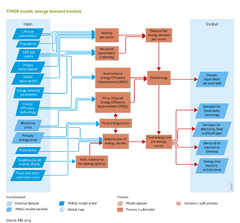Energy demand: Difference between revisions
Jump to navigation
Jump to search
No edit summary |
No edit summary |
||
| Line 9: | Line 9: | ||
|OutputVar=Demand for primary energy; Demand for electricity and hydrogen; Demand for traditional biomass; People dependent on solid fuel; | |OutputVar=Demand for primary energy; Demand for electricity and hydrogen; Demand for traditional biomass; People dependent on solid fuel; | ||
|Parameter=Taxes and other additional costs; Preferences; | |Parameter=Taxes and other additional costs; Preferences; | ||
|Description=Global final energy use has increased rapidly since the industrial revolution. Although, for a historical perspective, most increases have occurred in currently high-income regions, more recently the largest increase occurred in emerging economies. Given the aspirations for income growth in medium- and low-income countries, a continued high rate of growth in energy demand is to be expected in the coming decades, with important implications for sustainability. | |||
In the TIMER energy demand model, final energy demand is simulated as a function of changes in population, economic activity and energy intensity (Figure 4.1.1.1). The model considers five basic sectors: 1) industry, 2) transport, 3) residential, 4) services (both public and private), and 5) other (mostly agriculture). Within each of these sectors, final energy use is driven by the demand for energy services, such as motor drive, mass displacement, chemical conversions, lighting, heating and cooling. Here, the demand for energy is considered a function of three groups of parameters and processes: 1) activity data (e.g. on population and income, and more explicit, activity indicators such as steel production); 2) long-term trends that determine the intensity of use (e.g. economic structural change (SC), autonomous energy efficiency improvement (AEEI) and price-induced energy efficiency improvement (PIEEI)) and, finally, 3) price-based fuel substitution (i.e. the choice of energy carrier on the basis of its relative costs). The ways in which these factors are implemented varies across the different sectors. For some sectors, a detailed end-use service-oriented modelling approach was implemented. For other sectors, the description is more generic and aggregate. It should be noted that energy prices link the demand modules with other parts of the energy model, as they respond dynamically to changes in demand, supply and conversion. | |||
|Flowchart=EnergyDemandModel.png | |Flowchart=EnergyDemandModel.png | ||
|CaptionText=Flow diagram of the TIMER energy demand model | |CaptionText=Flow diagram of the TIMER energy demand model | ||
|AltText=Flow diagram of the TIMER energy demand model | |AltText=Flow diagram of the TIMER energy demand model | ||
}} | }} | ||
Revision as of 10:58, 12 November 2013
| Component is implemented in: |
|
| Related IMAGE components |
| Projects/Applications |
| Key publications |
Key policy issues
- How will energy demand evolve particularly in emerging and medium- and low-income economies?
- What is the mix of end-use energy carriers to meet future energy demand?
- How can energy efficiency contribute to reducing the growth rate of energy demand and mitigate pressures on the global environment?
Introduction
"model component" is not in the list (driver component, pressure component, interaction component, state component, impact component, response component) of allowed values for the "FrameworkElementType" property.
